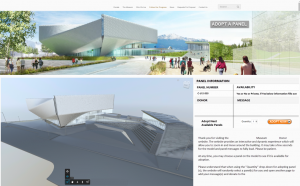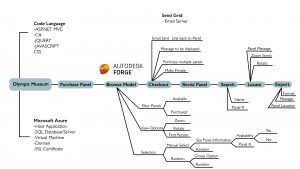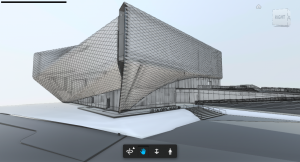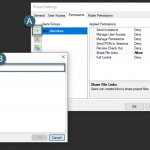Autodesk Forge Examples
Autodesk Forge is a powerful tool connecting design processes, data, and the web, allowing teams to create task automation and other innovative solutions. The abilities of the forge platform are extensive, potentially offering resolutions to thousands of complex problems in the architecture, construction, engineering, and manufacturing industries, and beyond.
- 1 – What is Autodesk Forge?
- 2 – What is an API?
- 3 – What can Autodesk Forge do?
- 4 – Autodesk Forge Examples
- 5 – Autodesk Forge File Formats/ Autodesk Forge Integration
- 6 – The Autodesk Forge Model Viewer
- 7 – Autodesk Forge Training
- 8 – How much does Autodesk Forge Cost? Is it free?
- 9 – Is Autodesk Forge Your Solution?
– What is Autodesk Forge?
All software products do certain tasks out of the box, however, sometimes end-users need to build upon those capabilities to meet their unique needs – when it comes to the world of BIM (Building Information Modeling) that’s where Autodesk Forge comes into place. Scott Sheppard, a program manager at Autodesk explains the Autodesk Forge platform “is a set of web service APIs that power the future of making things.” Autodesk created the Forge platform to allow users to expand their software’s connectivity and interoperability with the web. This allows multiple pieces of software to communicate and use different aspects of different software components like building blocks to customize solutions for the web. Autodesk Forge gives AEC teams the power to run automation scripts in the cloud, build apps that improve their BIM processes, view renderings of 3D models online, and much more.
– What is an API?
API stands for Application Program Interface. OpenSource.com explains that an API is an interface that allows users to write code that controls another application behind the user interface. This connectivity allows for multiple platforms to be integrated into one for the end-user, even if the applications have different programming languages.
– What can Autodesk Forge do?
Autodesk Forge has 9 primary areas of integration, including Authentication, Design Automation API, Reality Capture API, Data Management API, BIM 360 API, Model Derivative API, Viewer, Webhooks API, and Toke Flex Data Usage API.
– Autodesk Forge Examples
Autodesk Forge Example #1 – The US Olympic & Paralympic Museum Diamond Donor Program – An Autodesk Forge based interactive Online User Portal
The United States Olympic & Paralympic Museum is a privately funded cultural resource located in Colorado Springs, CO to honor the achievements of U.S. Olympians and Paralympians. Designed by Diller Scofidio + Renfro, the iconic form idealizes athletic elegance by twisting itself around a central atrium. Though just four stories in height, the museum’s structure is composed of fifteen independent elevations gradually spiraling down from the top floor. The exterior shell is composed of nearly 10,000 interlocking aluminum panels each independently modeled, fabricated, and precisely installed to reveal a beveled athletic armor that looks like metal in motion.
Challenge
While the building’s world-class architecture sets the stage for success, to achieve the museum’s vision for an equally impressive visitor experience, the collections within need to continually evolve and refresh as history happens. Responding to an outpouring of interest from athletes and the public, the U.S. Olympic & Paralympic Museum’s newly launched Diamond Donor Program allows individuals, communities, organizations, and businesses to have their names involved in the museum’s creation. The proceeds provide content funding that can live on for generations.
Using the individually modeled aluminum panels as the virtual tender, the program allows each panel to be figuratively adopted, like buying a star. For MG, the technological challenge was how to take an extremely robust dataset in the Building Information Model and make it accessible to the public in an intuitive, web-based format.

The Autodesk Forge Based Solution
In order to facilitate the precise panel fabrication, placement, and installation sequence required during the construction phase, each panel was assigned a serial number within the Building Information Model. This made each panel wholly unique and identifiable on the finished building, as well as within the BIM. MG worked with the museum’s leadership to conceptualize how users would interact with the model to virtually visit the museum and become invested in panel adoption. The platform allows users to navigate the 3D model of the museum from a first-person perspective, select a panel and adopt it, all while using a familiar e-commerce transaction process. Donors are then given the opportunity to create personalized messaging on their panel (or series of panels) and check out with their credit card. Sponsors are shown a real-time preview of their individual certificate of adoption and donor message, which will be printed and mailed to them. A unique URL is generated for donors to share privately or publicly.

A key component of MG’s development solution was Autodesk Forge. Alongside a variety of industry-standard web-development protocols, MG used Forge to create a web-friendly portal that streamlines the BIM model and presents it on a web page accessible from the desktop or mobile device. The resulting interface allows users to explore and interact with the building, both inside and out, without being overwhelmed by the model’s inherent intricacy. Through thoughtful systems integration, MG is using Forge to enhance and customize the connections between design and construction teams building structures such as the U.S. Olympic & Paralympic Museum all over the United States.
Results and Metrics
Since the release of the Diamond Donor Application, donations have poured in for the Museum from single individuals to large corporations. These donations will help fund future exhibits and programs at the nascent museum to recognize America’s accomplishments on the world’s premier athletic stage.
“We formed a strategic partnership with MG and they were able to take this wonderful intellectual asset in the Building Information Model and make it accessible to the public in an intuitive, web-ready way. The intent is to deliver an impressive visitor experience showcasing a collection of customizable content that refreshes continually. MG is an important part of the Diamond Donor Program, which funds that mission.”
Chris Liedel, CEO
The United States Olympic & Paralympic Museum

Autodesk Forge Example #2 – Georgia Pacific Forge POC
Autodesk and D3 Technologies developed a web application that integrates BIM360 and Forge functionality into GP’s EcoSys management portal. The POC allows the user to create and manage BIM360 documents inside EcoSys while leveraging the Forge API. The end goal will be to allow EcoSys users to upload entire projects into BIM360 through the integration giving the users a “Moment in time” ability to go back to a project at any stage and review the project and view any document within the browser.
The second web application is a deep contextual dive search engine that indexes and searches Revit and PDF files that live in BIM360. D3 extensively used the Forge API model derivative to fill an Amazon Elastic Search engine with the search data. This then allows the users to quickly find documents and open them within the webapp via Forge Viewer or directly through BIM360.
– Autodesk Forge File Formats/ Autodesk Forge Integration
Autodesk Forge is powerful and well connected! The Model Derivate API enables you to translate over 60 different types of source file formats into derivatives (output files) and view them in the Forge Viewer. See all of the formats Forge can use here.
– The Autodesk Forge Model Viewer
The Autodesk Forge Model viewer is not strictly for the Architecture, Engineering, and Construction industry. Forge allows for 60 different types of source file formats, enabling even manufacturing models to be viewed as well. You can play with models of different types in the Autodesk Forge Model viewer here.
https://viewer-rocks.autodesk.io/
– Autodesk Forge Training
While you can find training for most of the Autodesk products, there is no training for Autodesk Forge since it is coding and not a program like Revit or Word.
– How much does Autodesk Forge Cost? Is it free?
While the costs of most Autodesk products are straightforward, the pricing for the Forge platform is a little more complex. Pricing for Forge is contingent on the project, meaning the more complicated project the more it will cost. In addition, it is most likely that your team will need an expert to guide you through the process, and or complete the work for you. Need help navigating the process? MG can help guide your team to create your Forge solution, contact us here.
– Is Autodesk Forge Your Solution?
Do you have a unique project that Autodesk Forge could solve? We would like to hear about it. MG helps Architecture, Engineering, Construction firms, as well as property developers find, create, and build advanced software solutions. Start your journey with Autodesk Forge by contacting MG here.
Read this article to learn more about the benefits of Autodesk Forge, or contact MG today.



